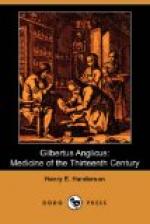Gilbert’s discussion of gout closes with a short and characteristic chapter entitled “Emperica,” in which he remarks: “Although I perhaps demean myself somewhat in making any reference to empirical remedies, yet it is well to write them in a new book, that the work may not be lacking in what the ancients (antiqui) have said on the subject. Accordingly I quote the words of Torror. If you cut off the foot of a green frog and bind it upon the foot of a gouty patient for three days, he will be cured, provided you place the right foot of the frog upon the right foot of the patient, and vice versa. Funcius, also, who wrote a book on stones, said that if a magnet was bound upon the foot of a gouty patient, he is cured. Another philosopher also declared that if you take the heel-bone of an ass and bind it upon the foot of the patient, he is cured, provided that you take the right bone for the right foot, and conversely, and he swore this was true. Torror also said that if the right foot of a turtle is placed upon the right foot of a patient suffering from the gout, and conversely, he will be cured.”
Gilbert’s discussion of leprosy (De lepra, f. 336 d) covers twenty pages and, according to Sprengel, is “almost the first correct description of this disease in the Christian West.” Freind says this chapter is copied chiefly from Theodorius of Cervia. See page 3 ante. If, however, I am correct in my conjecture that the Compendium was written about the year 1240, the copying must have been done by Theodorius, whose “Chirurgia” did not appear until 1266.
Leprosy is defined as a malignant disease due to the dispersion of black bile throughout the whole body, corrupting both the constitution (complexionem) and the form of its members. Sometimes, too, it occasions a solution of continuity and the loss of members.
The disease is sometimes congenital, arising from conception during the menstrual period. For the corrupt blood within the maternal body, which forms the nourishment of the fetus, leads likewise to the corruption of the latter. Sometimes the disease is the result of a corrupt diet, or of foul air, or of the breath or aspect of another leper. Avicenna tells us that eating fish and milk at the same meal will occasion the same result. Infected pork and similar articles of diet may likewise produce the disease. Cohabitation with a woman who has previously had commerce with a leper may also produce infection.




